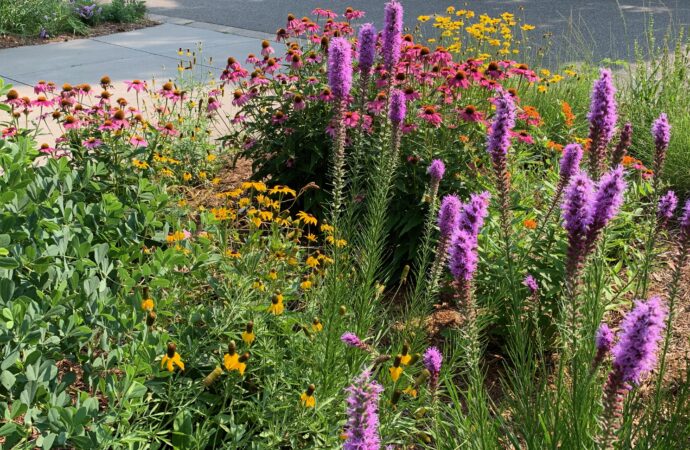All About Rain Gardens


What is a rain garden?
A rain garden is a planted area that is located below the height of the surrounding land, typically in a basin shape. This structure allows rainwater runoff and snowmelt from hard surfaces like roofs, sidewalks, parking lots, and compacted lawn areas to soak into the ground. The purpose of a rain garden is to improve water quality in nearby bodies of water, which are connected to hard surfaces through the underground storm drain system.
Why install a rain garden?
Rain gardens can reduce up to 90 percent of the pollution from rainwater flowing into them. They can be planted with shrubs or perennial flowers and grasses to increase their ability to absorb and filter the water and create habitat for birds, butterflies, and other pollinators. Minnesota native plants are often recommended for rain gardens because they do not require fertilizer and are more tolerant of local climate conditions.
Is a rain garden right for your property?
Rain gardens capture and filter water, keeping polluted runoff out of storm drains to help protect our lakes, rivers and streams. A rain garden will not work in all locations. Buried utilities, tree roots, soil type, how the water flows and other constraints are all barriers to installation. Technical assistance is available from your local conservation district to determine if a rain garden will work on your property.
- Ramsey County: Brian Olsen, 651-266-7280 or brian.olsen@co.ramsey.mn.us
- Washington County: Andrew Novak, 651-330-8220 or ANovak@mnwcd.org
Rain Garden FAQs
Does a rain garden form a pond?
No, rain gardens are designed so that all water soaks into the ground within 48 hours after rainfall. If water remains after 48 hours, something needs to be fixed. Call us or your contractor immediately if this happens.
Are rain gardens a breeding ground for mosquitoes?
No, mosquitoes need standing water for 7-12 days in order to hatch eggs.
Do rain gardens require a lot of maintenance?
While rain gardens do require some maintenance, it is not an exceptional amount for a garden. Watering and weeding are critical for the first 2-3 years while the garden establishes itself. After the garden is established, the need for regular care decreases.
How much does a rain garden cost?
This depends on the garden size and area conditions. RWMWD offers funding for 50-100% of rain garden projects within District boundaries through our Stewardship Grant program.
Funding for Rain Gardens Available
If your property is within RWMWD district boundaries, you may be eligible for Stewardship Grant funding. Check out more details and get a free site consultation.